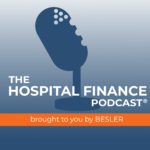![]()
In this episode, we are joined by Zachary Hartsell, Principal at SullivanCotter, to discuss their survey results indicating that organizations are anticipating changes to physician non-productivity-based incentives in 2020.
Podcast (hfppodcast): Play in new window | Download
Learn how to listen to The Hospital Finance Podcast® on your mobile device.Highlights of this episode include:
- Background on SullivanCotter’s COVID-19 Physician and Advanced Practice Provider Compensation Practices survey series.
- How organizations are handling furloughs and layoffs during the pandemic.
- How cash compensation and benefits have been affected by the pandemic.
- What are organizations looking at in terms of salary protections and incentive compensation for physicians?
- Some trends around redeployment and premium compensation for advanced practice providers
- And more…
Mike Passanante: Hi, this is Mike Passanante and welcome back to the award-winning Hospital Finance Podcast®. Consulting firm SullivanCotter recently released survey results indicating that organizations are anticipating changes to physician non-productivity-based incentives in 2020. To discuss the study results, I’m joined by Zachary Hartsell, a principal at SullivanCotter. Zachary, welcome to the show.
Zachary: Michael, glad to be here. Thank you for inviting me.
Mike: Zachary, today we’ll be talking about the results of SullivanCotter’s COVID-19 Physician and Advanced Practice Provider Compensation Practices survey series. What were you looking at, specifically, in this survey? And who did you survey?
Zachary: Well, happy to discuss it, Michael. SullivanCotter has actually conducted two surveys on this topic, one in April and one in May. And we really did them to provide insights to the client and– to our clients and to the market as to what was happening, in terms of trends of organizations responding to the pandemic from a workforce and rewards perspective. Both surveys had over 100 participants. And we saw a 70% repeat in participation from the first to the second survey. Participating organizations had revenues ranging anywhere from 400 million to 28 billion. And really, they represent the largest integrated academic and pediatric hospitals and health systems in the country. The goal of the survey was to understand the changes that occurred or are being considered related to physician APP compensation. And when we think about compensation, we think not only cash compensation, but things like incentives, premium pay, and benefits. We also wanted to understand what kind of compensation plan changes organizations were considering, as a result of the different workflows in response to the pandemic, such as redeployments, closed clinics, etc.
Mike: Got it. So let’s dig into something you just said there. What are you finding organizations are doing, in terms of furloughs and layoffs at this point?
Zachary: Great question, Michael, and something that we often get. Contrary to the attention-grabbing headlines, most organizations are not furloughing or laying off their employed physicians or advanced practice providers. In fact, less than 10% of survey respondents had implemented layoffs or furlough. What we’re seeing in place of that is nearly half of the organizations are instead reducing provider compensation or considering changes to benefit programs like retirement plans, CME, etc. For the minority of organizations who have looked at furloughs or layoffs, the consistent trend we are seeing is that organizations are focusing more on furloughs, temporary, than layoffs, which seem a little more permanent. Additionally, these changes are impacting the staff physicians and APPs more than they are the APP or physician leaders. When we think about organizations– when we look at organizations who have implemented furloughs, on average, the duration lasts anywhere from about three to four weeks. I will say, though, since our survey release, through conversations with our clients and media reports, we are seeing an uptick in the need to have, in some markets, more workforce actions like furloughs and layoffs, as due to the continued financial strain and the lack of patient volumes. But this is really variable market by market, organization by organization. And in our experience, it seems to be in part due to the pre-COVID financial health of the organization. I think this will be really important to monitor in the coming weeks and months, as we hit additional surges and/or volumes don’t return as projected. And if that were to happen, we could see a result in increased prevalence of furloughs and layoffs. Whereas if volumes return greater than expected, we are going to see more returning to work and even potentially new hiring.
Mike: That would be optimal. Zachary, how have you found cash compensation and benefits? How have they been affected?
Zachary: We’ve been seeing changes in the way organizations are handling compensation of their APPs and physicians as a result of COVID. But it’s not just the COVID pandemic, it’s also the economic fallout from that. And again, like with furloughs and layoffs, these changes are occurring at variable paces and are really dependent on the degree of disruption the organization has experienced and the pre-COVID financial health of the organization. Now, within this, we have seen some things that we expect, and we’ve seen some surprises. For example, one surprise was, we have not seen a lot of premium pay for physicians or APPs working in frontline areas, with only 10% of organizations reporting that they’ve considered or have implemented premium pay compensation. This was something that we were expecting a lot more of. Whereas compensation protection for physicians were expected, and we see them present. As of May, about half the organizations were implemented or considering implementing temporary compensation floors. And this is for the non-frontline physicians. And this is understandable, given the continued loss of volume and the loss of patient revenue. Interestingly, though, while half of the organizations were protecting physician compensation, this number was actually decreased from the April survey by about 10%, indicating that some organizations that may have offered initial protections, had lifted those protections. Benefits are another area where we are seeing organizations making changes. In our May survey, about 35% had implemented or were considering changes to benefit programs such as reducing or eliminating retirement plan contributions, reducing or eliminating CME funds or time off, or reducing PTO time.
Mike: Zachary, let’s talk specifically about physicians for a moment. What are organizations looking at, in terms of salary protections and incentive compensation for them?
Zachary: As I mentioned above, it really is dependent on whether they were frontline providers– and I mean ED, critical care, hospital medicine, or non-frontline. As we said, for frontline providers, we saw very little in the way of premium compensation. For the organizations that did use a premium, we have seen a bit of an interesting shift. Initially, those were all applied as a percentage increase to the shift rate. But as financial situations have evolved, the structure of those premium payments has changed to a one-time stipend or bonus. We talk about non-frontline physicians. We talked about half the organizations having cash compensation protection for physicians experiencing a loss of shifts or productivity, as a result of the loss of elective procedures or non-emergent visits. When you kind of break down the detail, and you look at the scope of the protection, about 40% of organizations were providing about 100% of historical cash compensation protection, about 40% were protecting between 75 and 90 percent of historical compensation, and anywhere from 5 to 15 percent were protecting somewhere in the neighborhood of 50 to 75 percent of historical compensation. So there was a significant amount of protection being offered. As organizations begin the slow recovery out of the COVID crisis, and as people start to think about how do they reconcile the health system financial sustainability, I think that these compensation protections are going to be more in the limelight. As we said, that organizations are starting to lift them a bit, and I think as protections linger on, or market conditions create the need for subsequent protections, we’ll likely see that the increase of organizations requiring repayment of these– currently it’s about 22%. But as this continues on, we may see more and more organizations requiring repayment. One last thing to talk about with physicians would be the incentive component. And when we talk about incentive, nearly 40% of organizations plan to modify physician incentive plans for the remainder of 2020. When we talk about incentives, though, in this context, we are specifically talking about non-productivity incentives, things such as value-based incentives, or the system-wide incentives that physicians are eligible for, not the productivity incentives that we spoke about earlier. Additionally, about a quarter of organizations anticipate making future changes to the physician compensation plan as a result of the fallout from COVID-19.
Mike: Zachary, the work of many advanced practice providers was affected by COVID-19. Tell us about the trends you saw around redeployment and premium compensation for those providers.
Zachary: Well, as we discussed earlier, Michael, this is really interesting to me, being an advanced practice provider myself. And I think that this has really been one of the Ah-ha moments for organizations– they have had as a result of COVID. And that is the value that the flexibility of the APP workforce can provide the organization. For example, 71% of organizations have redeployed or plan to redeploy their non-frontline APPs into frontline specialties. And I’ll tell you anecdotally, that’s not just the ICU or hospital-based units. But it’s things like COVID screening clinics, telemedicine, infectious disease, and pulmonary medicine clinics. A critical consideration for organizations looking to redeploy their APPs is ensuring that they’re redeploying the right skill set of APPs. This is incredibly important and can’t really be overlooked. And this is often best accomplished through performing an organization-wide skill inventory of your APPs. Other important considerations when thinking about redeployment include clarifying emergency credentialing policies, reviewing staffing plans, and providing training for new care delivery and documentation requirements. On the compensation side, it’s noted about half the organizations have made reductions to cash compensation, with the average reduction of approximately about 10%. While APP incentive programs are not as common as with physicians, in our survey, about two-thirds did say that they have incentive plans, which is higher than what we typically see. Our May survey indicated that about a quarter of them were modifying their incentive plans. And when we break down the data, that was fairly evenly split between true modifying the plan, reducing the plan, or eliminating the incentive opportunity. I think what we’re starting to see now is organizations think about the future. And in our May survey, about 15% of organizations anticipated making changes to future APP compensation, as a result of COVID-19, with another 47% unsure. I suspect that, as the pandemic continues, and as there’s more clarity around the financial situation post-pandemic, I suspect we’ll have more organizations making decisions about whether they will be making future changes to APP compensation.
Mike: Do you have any recommendations for organizations that are revisiting their compensation packages for providers, as a result of the pandemic?
Zachary: This really may be a crossroads for physician and APP compensation, as it remains really to be seen as the COVID-19 will serve as a referendum on the traditional compensation programs. We imagine that there will be organizations who will use this disruption to escalate the movement away from productivity-based compensation to more performance-based compensation. I’ll tell you, though. There will be other organizations that will see this as an opportunity to double down on productivity in order to try to see a quick financial recovery. I think for all organizations, the overall question is, “Can you afford to return to the old model? Or is this time of disruption a chance to reset using a different formula?” I think the challenge that most organizations will face is how to make these long-term decisions when there’s still so many unanswered questions. How long will the COVID disruptions last? I think what’s going to happen to telehealth and the payments. What impact will the rise of the uninsured be on organizational finances? And something that’s not been discussed as much but will have a big impact is the impending CPT coding changes, and how will those impact organizational finances and the physician compensation in the future. As healthcare organizations attempt to plan for these uncertainties, there’s going to be a need for more efficient operating models. I think there’ll be some right-sizing of cost structures, and reassessing the organizational processes and structures to become a little more clear. In that, I think organizations should be thinking about taking inventory as, “Do you have a clear and consistent base performance and work expectations of all your physicians and APPs? Do you have physicians and APPs working at the top of their license and training and are aligned with the outcomes, like patient access, throughput, and quality? And finally, do you have a compensation philosophy and a model for physicians and APP that is aligned with organizational goals, that is equitable, externally competitive, efficient, and easy to administer? And most importantly, is it understandable to the physicians and APPs? A clear compensation strategy that is paired with a clearly-defined performance and clinical work expectations are the critical components that leaders can hold the clinicians accountable to and utilize in order to then differentiate performance, and in turn, compensation in the future. As the COVID-19 pandemic continues to evolve, we will continue to monitor the market and provide updates to the trends we shared here today. I think these trends are important to keep an eye on for organizations to consider while they’re analyzing their own compensation plans and financial positions.
Mike: Zachary, if someone wanted to read more about the study results, where can they go?
Zachary: Go to www.sullivancotter.com and look under our resources page. You can also follow SullivanCotter on LinkedIn, where we regularly post compensation trends and insights related to COVID-19 and physician and APP compensation. Finally, I’m happy to answer any specific questions at zacharyhartsell@sullivancotter.com.
Mike: Zachary Hartsell, thanks so much for stopping by today and talking with us on the Hospital Finance Podcast.
Zachary: Thank you again, Michael. I appreciate the invite.





